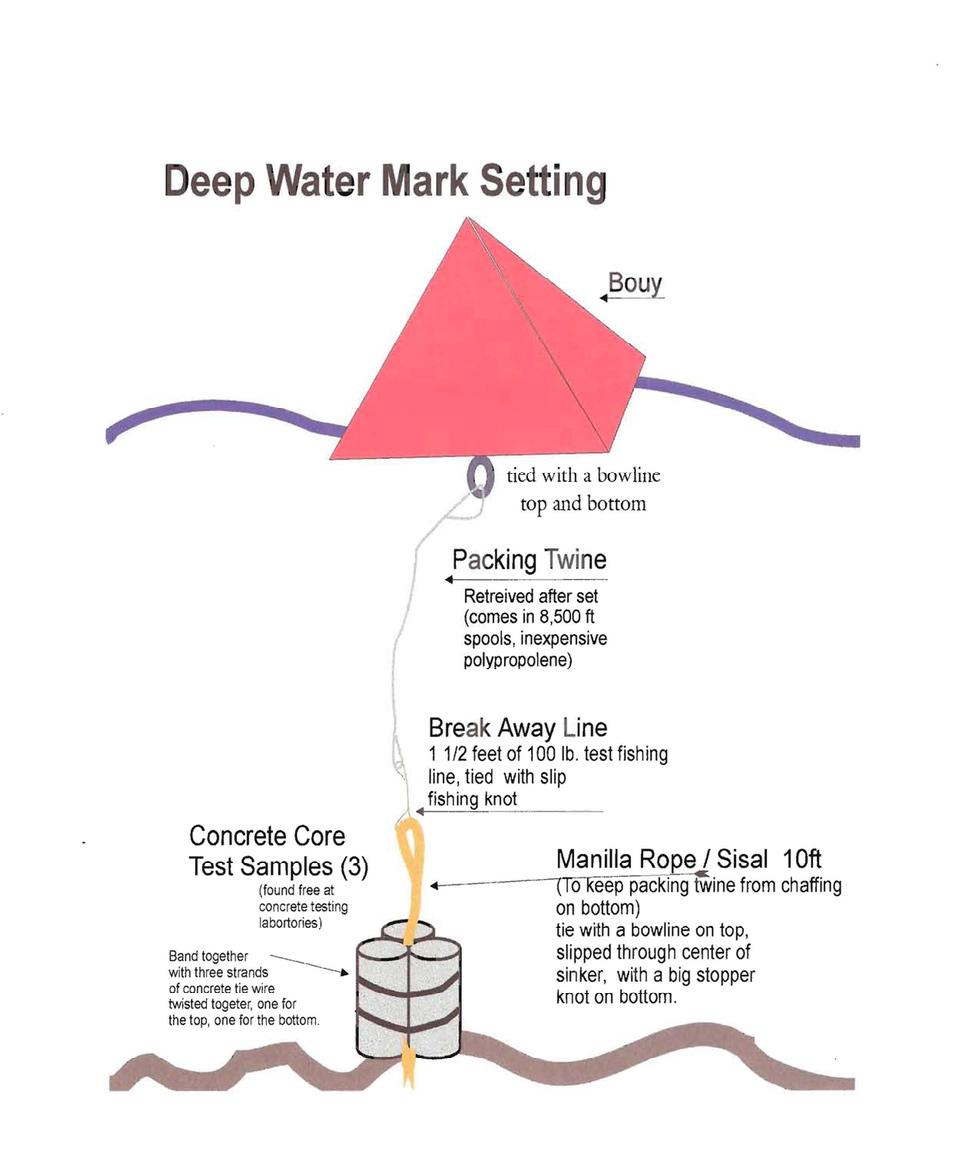 BUOY SETTING INSTRUCTIONS
BUOY SETTING INSTRUCTIONS
On race day contact and communicate with the Principal Race Officer (PRO), let them know you are ready and able to help set marks.
The buoy setting boat needs to have a working VHF radio that can receive and transmit on Channel 78 (preferred), or arrange with the PRO for another channel. If the committee boat has a radio, the club hand-held VHF can be used by a mark setting boat.
Coordinate with the PRO about getting the mark equipment for the mark you will be setting. Load enough packing twine for deep water set (2,000 to 5,000 feet), the mark, and the sinker set in a plastic milk crate.
The sinker set should already be made up, consisting of three concrete core samples strapped together with concrete wire and a manila rope going through the center formed. There should be a knot on one end of the manila rope and a bowline on the other with the 100 lb. test monofilament breakaway line attached.
Tow the inflated tetrahedron mark with a line attached to the ring on one corner.
Be sure to not foul the line or mark in your prop, tow at low speeds.
Tow to general area where you will be setting the mark.
The yellow mark is set to the south of the orange mark.
Establish radio communication with the race committee boat, and await their instructions as to where to set the mark. The R/C will guide you to the proper destination.
When you have reached the spot indicated by the R/C, deploy your mark.
Tie the packing twine from the box to the end of the breakaway monofilament on the sinker with a bowline and cinch up the monofilament slipknot.
Lift the sinker set out of the milk crate and lower it into the water.
Make sure that the packing twine is running free and does not snag on anything.
The person feeding out the twine, making sure it is running free, should have a knife on him/her that is readily available in case they get caught by the line and pulled overboard.
You will not be able to break the line by swimming against it, and you will not be able to swim against the descending sinker. BE CAREFUL.
The boat operator should try to keep the boat stationed over the sinking weight, not letting too much drift affect the scope.
Do not foul the twine in your prop.
Do not pull on the line as it is going down, you could cause the sinker to break the monofilament.
Do not let the packing twine chafe against anything it could break the twine and lose the sinker set.
Once the sinker hits the bottom, and this may take awhile depending on depth, you will feel the line stop feeding out.
Do not be too hasty, the sinker could still roll some and start to take line again.
Once you are sure it has stopped feed out another 50 to 60 feet of line for scope.
Cleat the twine to a handy cleat that can be easily freed again, guard against chafe, and cut the twine another ten feet back from the cleat.
Tie this end with a bowline to the middle ring of the tetrahedron, uncleat the twine release the mark with the handles in the up position.
Once the mark is set and looks stable, notify the R/C that the mark is deployed, using the radio.
The mark setting boat has the privilege of checking in for the race by radio with the R/C by giving boat name and sail number. The mark setting boat then may prepare for their race.
PICKING UP THE MARK
Upon notification or at the request of the R/C a boat may pick up a mark. It is imperative that the RIC first be notified.
When picking up the mark, slowly approach the tetrahedron and have a crew member grab the mark by the handles. Be careful if using boat hooks that the mark is not damaged. Be careful not to foul your prop with the twine.
Pull the mark on board if possible and pull in 6 to 8 feet of twine, cleating it off on a stem cleat. Cut the twine free of the mark at the ring and deflate the mark by opening the valve.
Place a towel or some kind of cushioning between the twine and the boat to prevent the twine from chafing, which will cause it to break.
Motor the boat toward shore at a slow to medium speed. The twine will get very taunt and it may take awhile for all of the scope to be stretched out. Keep going until it breaks at the breakaway line near the sinker. You will notice that the twine is now more horizontal than before. You should stop the boat and haul the twine in, putting it in a plastic bag for disposal on shore. You should see the bowline in the twine at the end, signifying a complete recovery of the plastic line.
Notify the R/C that the mark is secure, return it to the clubhouse and let the R/C know that is returned.
